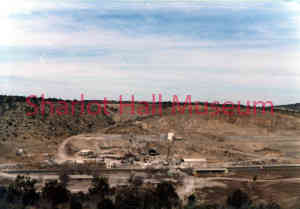Nelson Lime Mine
details
Unknown Unknown 1600.0399.0017.jpg M - 399 Color 1600-0399-0017 m0399pq Print 3x5 Historic Photographs 1978 Reproduction requires permission. Digital images property of SHM Library & ArchivesDescription
Nelson Lime Mine, Nelson, Yavapai County, Arizona, c. 1978.
The Nelson Lime Mine is the oldest continuously mined limestone quarry in Arizona. Unlike most traditional mining operations, lime is not excavated from a pit but rather from the tops of mountains down. Mining limestone at the Nelson facility originated in the late 1800’s and it continues today.
The mine has changed ownership many times since its inception. It is currently called the Lhoist Nelson Mine; it is about an hour outside Kingman, Arizona adjacent to the Hualapai Nation Reservation near Peach Springs. The Nelson plant is owned by the Belgium family (Lhoist) who has a long history of working in the lime industry.
The Nelson name came from a conductor, Fred Nelson, of a construction train that arrived in the area in late 1882. The mine was started by a William Carey, who filed a gold claim there in 1893. His efforts were unsuccessful. Finding little gold, Carey instead built the first lime kiln after noting the abundant mineralization deposit of sedimentary Redwall Limestone in the area. Red paydirt.
The town of Nelson was founded and grew to be a complete mining community with stores and schools. A post office was established by 1904. The town’s population was railroad and mine families mostly. Many employees of the mine also came from the nearby reservation, as did some of the wood used to fuel the operations.
Lime was an important commodity in the early West. It was an important additive for making mortar and plaster, and as importantly, used for manufacturing glass and castings, refining sugar, and tanning leather. The oxidation of lime was used in early theatre spotlights; it created a brilliant and warming light, hence the origin of the phrase “standing/basking in the limelight.”
In its early days, the Nelson Mine was producing about 20 tons per week. Historically, the products of this mine helped to rebuild San Francisco after the devastating 1906 earthquake and fires. This work, and growth in the west, spurred the plant to increase operations from six to nine shaft kilns. Before World War II, the Nelson Mine was shipping 250 loaded cars of lime a week, totaling about 100 tons.
After World War II, the mine was sold and the railroad depot was closed in the 1960’s. Employees and their families vacated the small company-owned town by the 1970’s. A new kiln was constructed about a mile northeast and the old plant converted for storage uses. The old stores and school are no longer standing, and even the cemetery was moved to a site nearer the new plant’s boundaries.
Purchase
To purchase this image please click on the NOTIFY US button and we will contact you with details
The process for online purchase of usage rights to this digital image is under development. To order this image, CLICK HERE to send an email request for details. Refer to the ‘Usage Terms & Conditions’ page for specific information. A signed “Permission for Use” contract must be completed and returned. Written permission from Sharlot Hall Museum is required to publish, display, or reproduce in any form whatsoever, including all types of electronic media including, but not limited to online sources, websites, Facebook Twitter, or eBooks. Digital files of images, text, sound or audio/visual recordings, or moving images remain the property of Sharlot Hall Museum, and may not be copied, modified, redistributed, resold nor deposited with another institution. Sharlot Hall Museum reserves the right to refuse reproduction of any of its materials, and to impose such conditions as it may deem appropriate. For certain scenarios, the price for personal usage of the digital content is minimal; CLICK HERE to download the specific form for personal usage. For additional information, contact the Museum Library & Archives at 928-445-3122 ext. 14 or email: orderdesk@sharlot.org.




